
- Home
- UpFront
- Take One: Big story of the day
- War, apathy throw Indian medical students in Ukraine in disarray
War, apathy throw Indian medical students in Ukraine in disarray
With complicated government regulations and limited seats in India, uncertainty looms over the future of aspiring medicos who've returned from the war-torn country
_20220316022208_102x77.jpg)
Mansvini has been a journalist with Forbes India for two years now. She joined within months of graduating in Mass media from Sophia College, Mumbai. She writes on startups, education, employment, agriculture, lifestyle, and everything that intrigues her. As a part of the digital team, she manages Forbes India's website and social media presence and helps in organising events. She made a career out of asking questions, a habit she can't get rid of. She operates in extremes, you'll either find her reporting on important issues or travelling and partying her heart out.
- Coke Studio returns with a renewed approach to put India's musical prodigies in the limelight
- Can the experiential learning of Masters' Union be the Indian MBA alternative?
- Are dietary supplements as nutritious as they claim?
- Forbes India Leadership Awards 2023: Honouring the stubborn leaders
- Anuv Jain: Turning memories into music
- Azim Premji to Akshay Kumar, the top 10 donors to India's Covid-19 fight
- Akshay Kumar only Bollywood star on Forbes list of highest-paid actors
- From sweets to a university, Punjab's Lovely Group is far from done
- Is India ready for home schooling?
- Legitquest: On a quest to building a legal technology framework in India
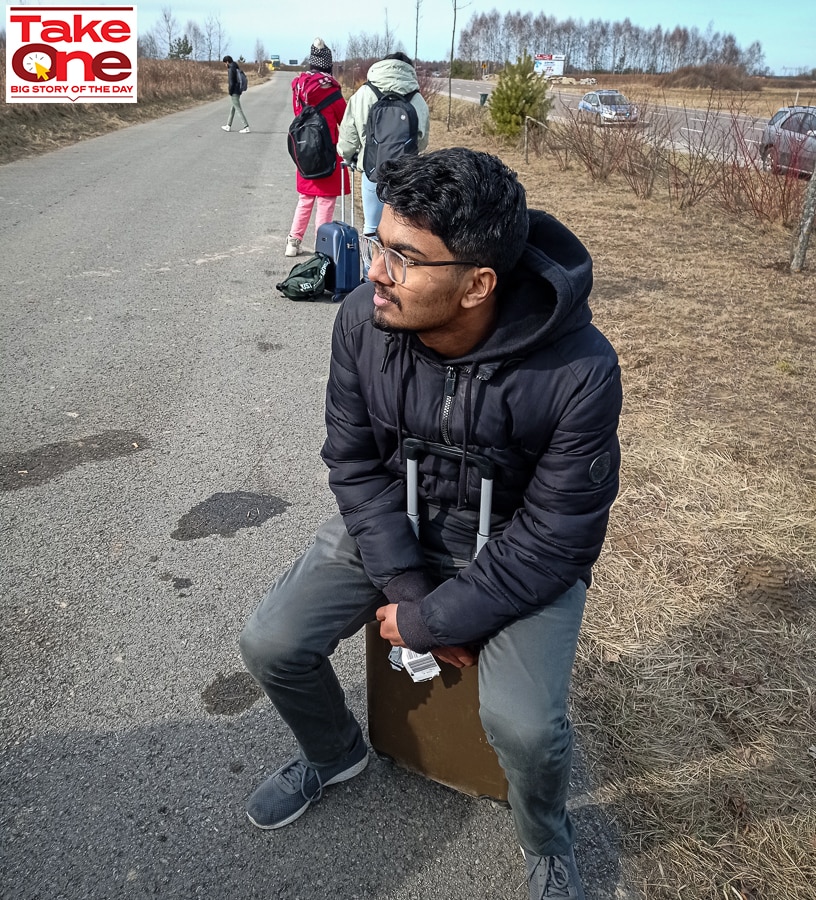 Mohit Malekar, a second-year Indian medical student from Lviv Medical University waits to get through at Budomeriz check point on the Ukraine border. March 1, 2022
Mohit Malekar, a second-year Indian medical student from Lviv Medical University waits to get through at Budomeriz check point on the Ukraine border. March 1, 2022
After four years of his MBBS education, Aditya Vashist, a 24-year-old student of the Kharkiv National Medical University in Ukraine is staring at an uncertain future, with the fear of losing a year of education or having to discontinue the course altogether. “I don’t know what we will do if the classes don’t resume. The city is being demolished, lecturers have fled the country to take refuge in neighbouring states and all the students are waiting to get some clarity on when and how the university will resume classes,” says Vashist.
Related stories
While a usual day for Vashist a month ago was about attending classes and preparing for exams, is now just a constant wait for communication from the university. “I can’t do anything since classes aren’t being conducted, I can’t proceed with the course, we aren’t supposed to intern at this stage of my degree, it’s just a constant wait for clarity,” he says.
Russian troops invaded Ukraine on February 24 and since then the country has been in shambles with continuous bombings and destruction. Around 18,000 to 20,000 Indian students are enrolled in 33 medical universities in Ukraine. After the invasion, the Indian government organised special flights to evacuate the students from the disturbed state.
“It’s very difficult to attend classes right now, teachers are concerned about the uncertainty of operations of the university. Just today, while attending an online class we could hear sirens from our lecturer's end, she ran to her basement to hide and the class got postponed,” says Mohit Makekar, a second-year MBBS student of Danylo Halytsky Lviv National Medical University, Lviv whose classes resumed on March 14.
While online classes have commenced for a handful of universities, students are worried about how long would they be able to manage online education. “The pandemic already made us miss out on practical, in-person classes, and now this war is adding to that. We can’t learn a nuanced course like MBBS online, we’re missing out of so much practical knowledge,” says Tanya Bajpai, a fifth-year MBBS student at the National Pirogov memorial medical university in Vinnytsya, Ukraine.
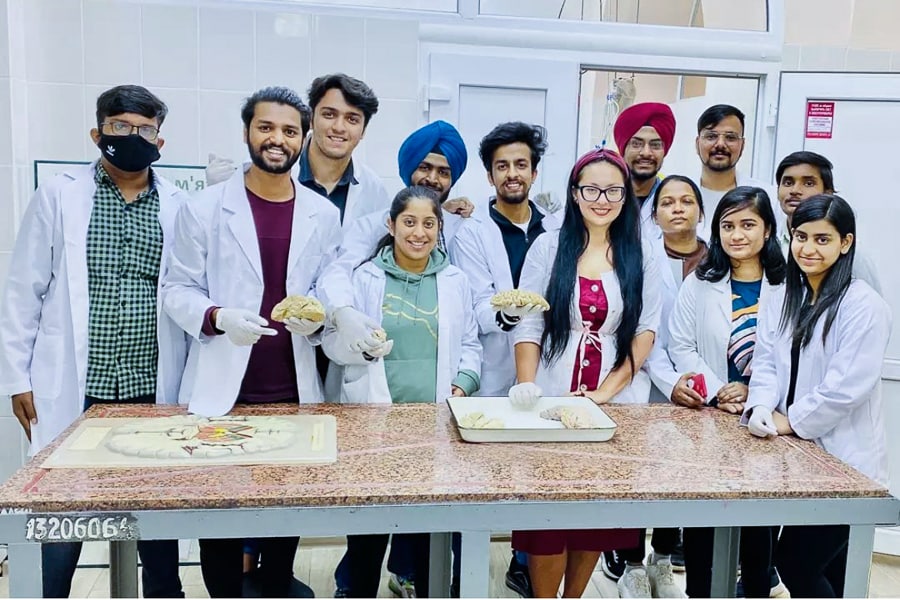 Indian students at a lecture at the Kharkiv National Medical University, in the days before the Russian invasion
Indian students at a lecture at the Kharkiv National Medical University, in the days before the Russian invasion
The National Medical Council (NMC), the governing body of medical education in India, doesn’t permit online education for foreign medical graduates to attain a licence to practice in India. It’s a problem that Indian medical students locked out of China also faced when their universities switched to online teaching due to Covid-19.
The NMC also mandates Indian students abroad to complete the entire course, training, and internship, or clerkship, in the same foreign medical institution throughout the course of study. This makes the transfer to other universities outside Ukraine—a proposed alternative for Indian students under the current circumstances—impossible at the moment.
“During the pandemic, most medical colleges in Ukraine switched to online delivery of courses, which is not recognised by the NMC. This, along with current policy guidelines around NEET (National Eligibility Cum Entrance Test) & NEXT (National Exit Test) criteria, credit transfer, and internships have increased the hurdles for a continued medical programme for students. Also, the current regulations do not permit credit transfer for Indian nationals who are pursuing MBBS outside the country,” says Niranjan Jayakumar, chief international business officer and senior vice president at Manipal Global Education Services.
“Ukraine follows the American Medical System whereas Indian medical colleges follow the British Medical System, which means several bridge courses will have to be brought in to consider transfers for students in India,” he adds.
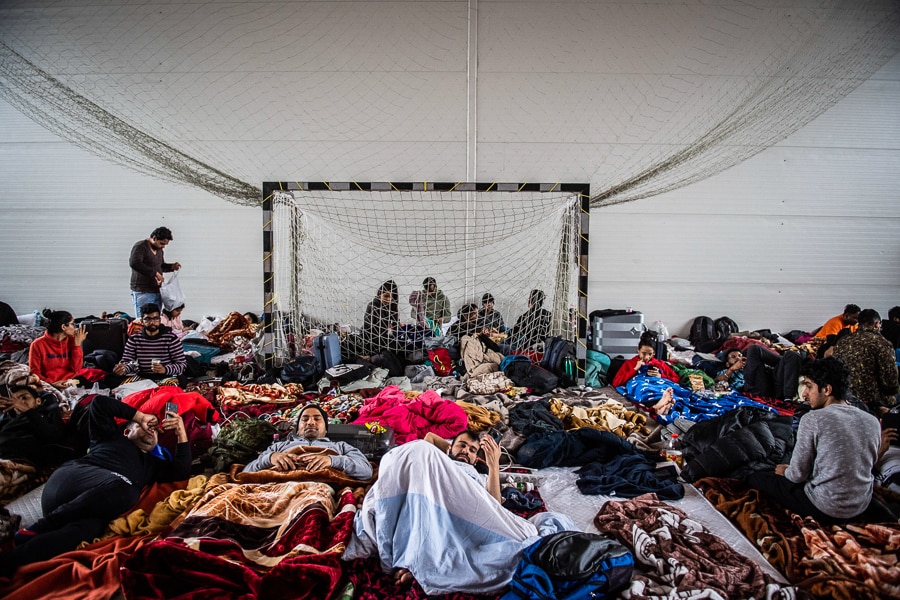 Hundreds of Indian students from the Kiev Medical School are housed in a reception center in Milisauti, Romania, on March 3, 2022, while waiting for an airlift to take them back to India. Photo by Alessandro Serrano/AGF/Universal Images Group via Getty Images
Hundreds of Indian students from the Kiev Medical School are housed in a reception center in Milisauti, Romania, on March 3, 2022, while waiting for an airlift to take them back to India. Photo by Alessandro Serrano/AGF/Universal Images Group via Getty Images
Adding to the conundrum...
Most students go to Ukraine to pursue medical, dental, and nursing courses. The incentives are lower fees and cost of living, easier admission norms, and access to jobs. The cumulative MBBS fee in countries that are preferred for medicine—such as Ukraine, Uzbekistan, Kazakhstan, and Kyrgyzstan—is around Rs 35 lakh, including the cost of education and living expenses.
In India, however, the MBBS course fee for government medical colleges ranges from Rs 20,000 to Rs 7.5 lakh, while the MBBS fee for private colleges can range from Rs 75 lakh to more than Rs 1 crore.
The situation is particularly dire for students who have taken education loans for their courses in Ukraine. “Getting a loan is a complicated and long process in itself, there are extensive background checks and mortgages involved. If in case the degree gets delayed, either the bank will increase the interest rates or stop paying the additional amount,” says Abhijeet Ashok Thorat, a fifth-year MBBS student at Odessa National Medical University, who had taken an education loan in 2018.
Thorat explains that, in a typical loan, around 75 percent of the tuition fees is financed by the bank and is directly transferred to the university concerned. “With an interest rate of 11 percent, we get around 5-6 years after the completion of our degree to return the loan,” he says.
“Usually there is no consideration for waiver of education loans in a situation that is as disruptive as a war; the same applies to a global pandemic,” says Prateek Bhargava, founder and CEO, Mindler, a career guidance platform. “The obligation to repay the loan remains as is, and the principal amount sanctioned has to be returned. Some banks might oblige the borrowers by giving an extension but even in that case they would benefit by the higher returns,” he says, adding that the only ray of hope is for the students to approach the lenders to work out a feasible solution.
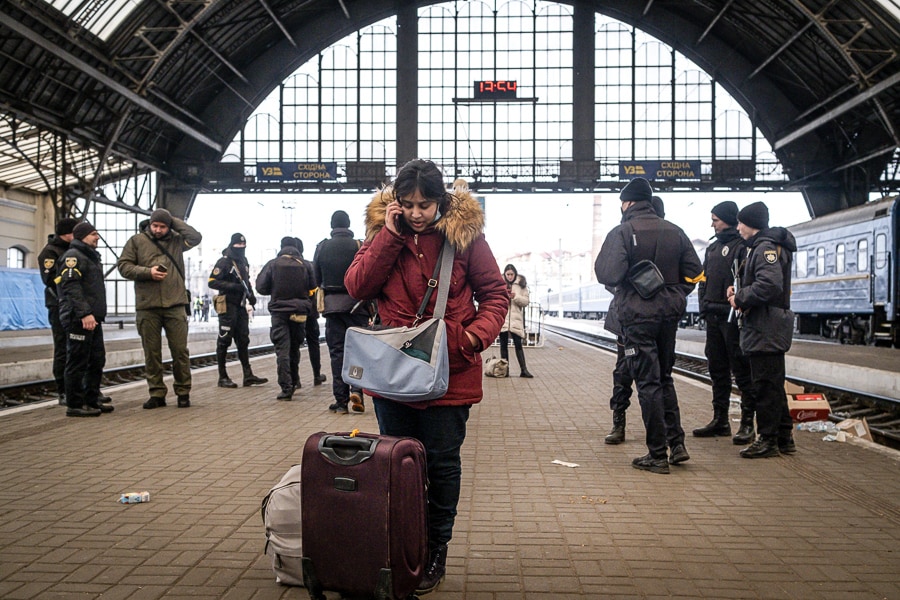 An Indian student from Sumy in Eastern Ukraine arrives at the main train station in Lviv, Ukraine, on March 9, 2022, through a humanitarian corridor created to evacuate them. Image: Adri Salido/Anadolu Agency via Getty Images
An Indian student from Sumy in Eastern Ukraine arrives at the main train station in Lviv, Ukraine, on March 9, 2022, through a humanitarian corridor created to evacuate them. Image: Adri Salido/Anadolu Agency via Getty Images
While uncertainty looms large on the future of Indian students in Ukraine, what is adding to their woes is the lack of communication from Indian authorities on the next steps. “Ministers are promising us they’ll help in increasing the seats at the Indian medical universities to accommodate us as a one-time measure, but there is no communication from the NMC,” says Bajpai. “Getting in an Indian university is one of the hardest things a medical student has to do in the course of their education; it would seem unfair for the current students to let us join them in the middle of the course,” she says.
“Even if the NMC allows for transfer to universities outside Ukraine, the procedure would be very complicated. There would be differences in the cost structure, the course pattern, and it would be very difficult for us to cope with a completely new approach to learning. Ukraine is part of the European Credit Transfer System but a move to institutions outside the country is not easy. There will be many monetary and regulatory hurdles,” explains Tobin Koshy, a fourth-year student at the Odessa National Medical University.
Dr P Ravi Pachamuthu, chairman of SRM Groups and the chancellor of SRM University Delhi, worries this uncertainty might make the students lose confidence in medical education. “The situation right now will complicate these students’ future aspirations as a sudden break could stifle their ambitions of becoming a doctor. While also making them directionless in their career, since they are unclear with the current educational impasse are without any expert-based advice, mentoring and teaching to become qualified for medical service,” he says.
NMC's regulations for foreign medicine graduates provide a 10-year window for students to obtain their degrees, complete their internships (one year in Ukraine and India respectively), and apply for Foreign Medicine Graduates Examination to receive their licences. A medical student in Ukraine completes her studies in six years followed by two years of internship—one in Ukraine and another one year in India—making it a total of eight. “If we lose time to complete the course due to this war, our ability to become a licenced practitioner would take a hit,” says Bajpai.
“Students have only two years in which they have to qualify the Foreign Medical Graduate Examination (FMGE), following which they are licenced to practice in India. The NMC should consider revising the 10-year window period regulation,” says Dr Rimy Dey, committee head, post graduate Studies, IMA-JDN (Indian Medical Association—Junior Doctors Network). “Sadly, the pandemic has already brought a standstill to the career of thousands of Indian medical students who were pursuing their medical courses in China and have been educationally languishing because they are unable to go back to their medical colleges. The Ukraine situation only adds to the argument as to why this revision of this stringent regulation is much needed,” she adds.
What led Indian students to choose Ukraine?
India is home to more than 16 lakh students who appear for NEET, the entrance exam for MBBS and BDS courses, with only 88,120 MBBS seats and 27,498 BDS seats available for admission. Of these, around 50,000 seats are at the 313 government-owned medical colleges, which are the most aspired seats because of the better quality of education and affordability as opposed to private colleges in India.
This cut-throat competition makes even the most deserving candidates miss out on opportunities in their home country, which is where they start looking at options abroad. “I had cleared NEET and got a decent score, but not enough to get into a government college, and private universities are way too expensive to get in. Add to that, quotas bring down the available seats for general category students. That’s when I started exploring options, why would I pay so much in India when I can get the same knowledge from universities abroad at half the cost,” says Koshy.
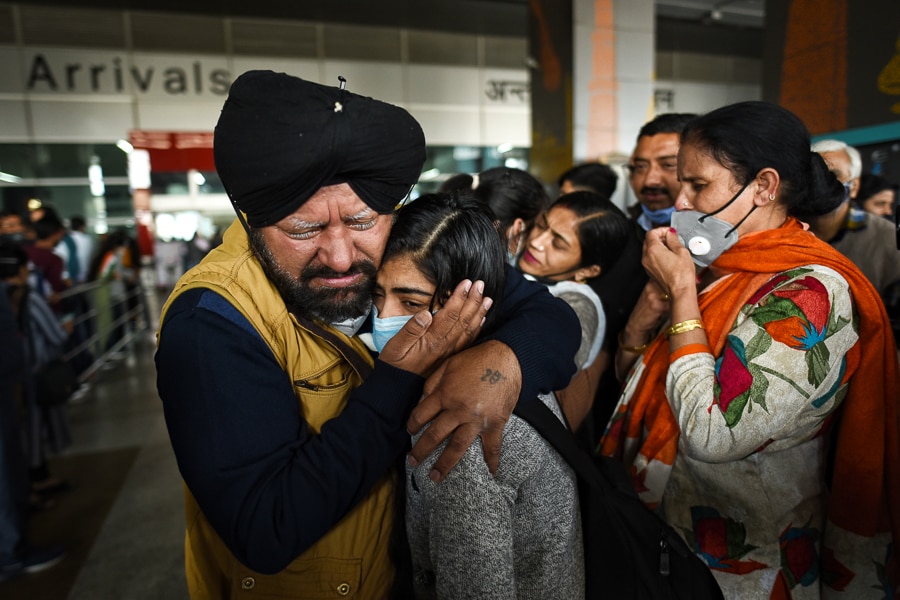 A student embraces her father overcome with emotion at the international airport in Delhi upon her return from conflict-torn Ukraine on an Indian rescue aircraft on March 5, 2022 in New Delhi, India.
Photo by Sanchit Khanna/Hindustan Times via Getty ImagesThere is a massive supply-demand gap in medical education in India. The dearth of available seats, especially for the general category, affordability concerns, and the complicated admission process make students opt for education abroad. This comes in the light of the fact that India has one government doctor for every 10,189 people, while the WHO recommends a ratio of 1:1,000. The country has a deficit of 600,000 doctors, and the nurse-patient ratio is 1:483, according to the Center for Disease Dynamics, Economics & Policy (CDDEP) report.
A student embraces her father overcome with emotion at the international airport in Delhi upon her return from conflict-torn Ukraine on an Indian rescue aircraft on March 5, 2022 in New Delhi, India.
Photo by Sanchit Khanna/Hindustan Times via Getty ImagesThere is a massive supply-demand gap in medical education in India. The dearth of available seats, especially for the general category, affordability concerns, and the complicated admission process make students opt for education abroad. This comes in the light of the fact that India has one government doctor for every 10,189 people, while the WHO recommends a ratio of 1:1,000. The country has a deficit of 600,000 doctors, and the nurse-patient ratio is 1:483, according to the Center for Disease Dynamics, Economics & Policy (CDDEP) report.
What can be done?
Students and experts are turning to the government and the NMC for help. The Indian Medical Association (IMA), the national voluntary organisation of physicians in India, has asked Prime Minister Narendra Modi to increase existing seats by 2-5 percent in all government and private medical colleges in the country as a “one-time” measure.
The NMC, however, has scorned the idea. Vijayendra Kumar, an NMC official, told The Economic Times that there is no proposal to make an exception for medical students returning from Ukraine. “There are clear-cut rules for students pursuing medical education in other countries and the same will be followed for those returning from Ukraine,” he said.
While the NMC is holding discussions internally to evaluate the situation, attempts to contact officials for comment went unanswered.
Dr Pachamuthu proposes setting up a panel by the Indian government where major stakeholders, including the Indian Medical Association, the National Medical Council of India, government medical institutions, and private medical colleges, evaluate the situation at hand. “We should explore options for private-public partnerships and increase the number of medical institutions, whilst offering the students one-time relief by giving admission to Indian medical colleges through an ‘appropriate dispersed distribution system’ in line with the National Medical Commission’s policy of accommodating students in other colleges,” he says.
An addition to the number of seats in colleges is the need of the hour, experts say. “Starting next academic session, the government should provide additional seats in all government medical colleges to accommodate the students who were pursuing their courses abroad and were in the nascent stages of medical education,” says Dr Dey.
The Indian medical education infrastructure has been under the spotlight since the pandemic started, highlighting the devastating gaps in the county. The country is home to only 562 medical colleges that together offer 86,649 seats at most, according to the National Medical Council, of which 286 are public and 276 private.
The demand for an increase in the number of available seats for medical aspirants in government and private colleges has been floating for quite some time. This, however, isn’t an easy road. With India spending only around 1.35 percent of its GDP on healthcare and institutions being spread disproportionally in the country, the growth in the number of colleges and student intake is slow. Many states reserve 80 to 85 percent of their seats for residents.
“The government-private partnership in building medical colleges and accommodating Indian medical students from across the world in different phases of their career should be given due consideration. Increasing the number of seats in private medical colleges should be actively considered,” proposes Dey.
“International collaborations and partnerships can be explored with renowned medical institutions apart from making medical education affordable. Proper medical counselling is also the need of the hour that will help students prepare for the ground realities in medical education,” says Pachamuthu, adding that private Institutions alone cannot be a force multiplier. “The government should formulate a group of medical experts to periodically review the sector as well enhance this space with more focussed spending in research and development, with the focus on improving both quality and affordability.”
Most of the students enrolled in universities abroad want to practice in India after their course completion. “My friends and I want to come back to India and serve here. We have the same passion as students enrolled in Indian medical universities, it’s the other factors that let us choose education abroad. India needs more doctors and an investment in building infrastructure to accommodate education for more aspirants should be the key concern of the country right now,” says the 21-year-old Koshy.







